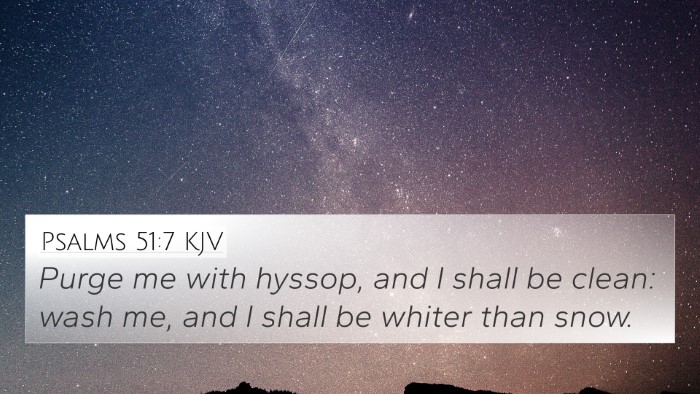Meaning and Interpretation of Leviticus 14:51
Leviticus 14:51 discusses the process of cleansing a house afflicted with leprosy, where the priest is instructed to take two birds, cedar wood, scarlet yarn, and hyssop. This verse plays a crucial role in understanding the broader context of cleanliness and purity in the Israelite laws.
Contextual Overview
- Healing and Restoration: The underlying theme here is about divine cleanliness and the restoration of what has been afflicted. The use of birds, which can fly, symbolizes the removal of impurities, akin to spiritual redemption.
- Priestly Role: This act exemplifies the priest's mediatory role in the Old Testament, showing the need for intervention in restoring purity.
Insights from Commentaries
- Matthew Henry: He emphasizes that the physical cleansing of the house parallels the need for spiritual cleansing in people's hearts, underscoring God's desire for purity in worship environments.
- Albert Barnes: Barnes notes that the detailed instructions demonstrate God's thoroughness in dealing with sin and uncleanliness, and how such matters are not to be taken lightly.
- Adam Clarke: Clarke draws attention to the symbolism of the materials used (e.g., cedar wood signifying strength and durability) that represent the eternal nature of God's laws.
Cross-References
- Numbers 19:17-19 - Discusses the purification through the ashes of a red heifer, highlighting the importance of ceremonial cleanliness.
- Isaiah 1:18 - Offers a connection to God's willingness to cleanse our sins, “Though your sins be as scarlet, they shall be as white as snow.”
- Matthew 8:3 - Jesus’ healing lepers draws a parallel to the laws of cleanliness in Leviticus, emphasizing the continuation of purifying practices.
- Luke 5:12-14 - Reinforces Leviticus’ practices as Jesus instructs the healed leper to follow the law of Moses for their cleansing.
- Hebrews 9:13 - Discusses the blood of goats and bulls used for purification according to the laws set forth in Leviticus.
- 1 Peter 1:19 - Connects the purity of Christ as the ultimate sacrifice for sin, reminiscent of the sacrifices portrayed in Leviticus.
- 2 Corinthians 6:17 - Calls believers to holiness, drawing from the idea of separation from impurity as displayed in Leviticus.
Thematic Connections
The themes of purification and holiness in Leviticus 14:51 link it cohesively with various narratives throughout the Bible:
- Cleansing and Redemption: The ongoing biblical narrative emphasizes the significance of divine purification from both physical and spiritual afflictions.
- Divine Intervention: The role of intermediary figures (priests, Jesus) in this process symbolizes God's active participation in human redemption.
Tools for Cross-Referencing
- Bible concordance can help locate related verses and themes.
- Utilizing a Bible cross-reference guide can enhance understanding of shared themes across different texts.
- Cross-reference Bible study methods allow for in-depth comparative analysis of verses, revealing deeper meanings.
Conclusion
In summary, Leviticus 14:51 serves as an essential verse that demonstrates the interconnectedness of law and spirit within the Biblical text. Through various commentaries and cross-references, we can discern the significant theological implications of cleanliness, purity, and the overarching narrative of redemption that resonates throughout the Scriptures.
Further Exploration
For those interested in exploring the connections further, consider examining the linkages between Old and New Testament teachings, particularly how Jesus fulfills and transforms the laws of Leviticus.



